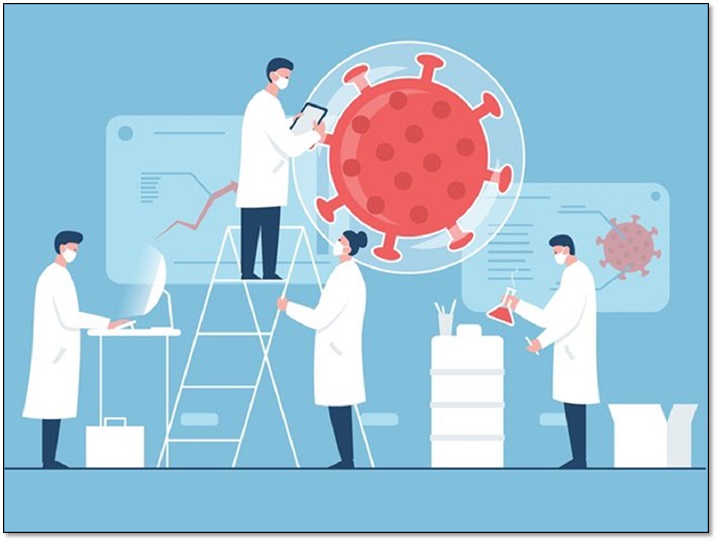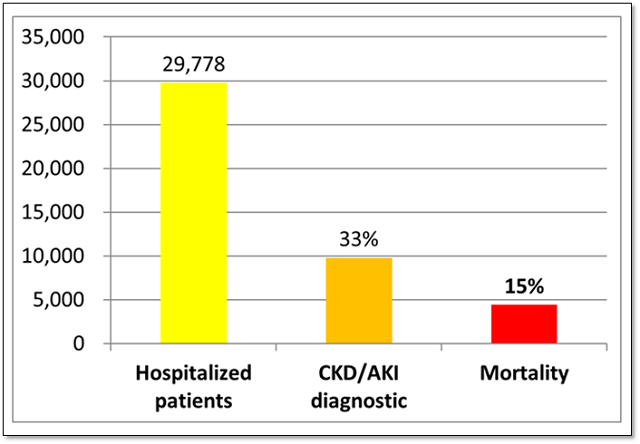eResearch | In early December 2019, COVID-19 (C19) virus cases emerged in Wuhan, China, and soon rapidly spread worldwide. By mid-May 2021, more than 160 million people were infected with C19, with 3.4 million deaths and still many with critical health conditions.

While global vaccination efforts seem to have effectively reduced the number of infected people in developed countries, the rest of the world remains in fear of a more bleak future. World health experts predict a long battle for this current wave of infections and many of them are forecasting recurrent and yearly battles for this now endemic, virus pandemic.
For decades, we have been accustomed to yearly flu vaccination and this approach along with current treatments produces a lower mortality rate than C19. One key point is that C19 is more contagious, virulent and carries more side effects if not treated early enough. Patients in critical stages have few treatment options and this results in a high rate of mortality and long-lasting health issues for those surviving.
Recent Scientific Articles on C19 Patients and AKI
Based on scientific articles published in the last three months, we can accurately state that the prevalence of acute kidney injury (AKI) in C19 patients is high, with a poor prognosis. We currently have a fairly good idea of the major risk factors: metabolic syndrome, diabetes, vitamin D deficiency, high inflammation (High C-Reactive Protein levels), and high blood pressure.
Although predominantly a respiratory infection, C19 often results in multi-system disease, with kidney involvement common in patients with moderate to severe disease. A clear picture now exists of the illnesses that patients are likely to be faced with when reaching the Intensive Care Unit (ICU): either AKI or ARDS (Acute Respiratory Distress Syndrome), or both. Both are life-threatening and the number of treatments guided by the US Health authorities (CDC, NIH, FDA) are limited and suboptimal.
The human kidney has emerged as a vulnerable target for C19; however, how this organ is affected by this particular virus and its variants remains unclear. The prevalence of AKI in C19 patients is high, with a poor prognosis. According to a meta-analysis of 28 studies (McAdams, Jan 2021), the diagnosis of AKI and Chronic Kidney Disease in hospitalized patients (mostly USA, China) ranged between 10-60% but with an average of 33% and a mortality of 15%.
FIGURE 1: Summary of 28 studies reporting CKD/AKI and outcomes in HOSPITALIZED patients with COVID-19

Vaccines, Antiviral Therapies, and C19
While vaccinations have significantly reduced the number of infected and hospitalized patients, hospitals are likely to continue to have patients in need of ICU-level care because they have not been vaccinated or the vaccine is not sufficiently protective after a few months.
Given the high level of publicity concerning the risk factors and C19 infections, very few people are likely to change their diet and lifestyle; people believe they are protected with vaccines.
Ongoing research continues to define the potential mechanisms of injury that include dysregulation, hypercoagulable, and hyperinflammatory states associated with C19. Targeting these pathways with anticoagulation, glucocorticoids or specific cytokine inhibitors seems to be a rational approach that may reduce the risk or severity of AKI. However, the impact of these therapies remains to be defined.
In addition, the role of antiviral therapies in the prevention and management of AKI is also unknown, particularly as patients with reduced kidney function, have been excluded from many clinical trials.
Relevant Recent Research Papers on Kidney Diseases
Three recent papers have attracted our attention and provide further information related to the diagnostic, treatment, and management of kidney disease associated with COVID-19 infection.
1) Nugent et al., JAMA Network 2021, AKI and Longitudinal Kidney Function after Discharge with and without COVID-19
- In a recent study of 1,612 patients with AKI, monitored after their hospitalization with an estimated glomerular filtration rate (eGFR) decline of 11.3 mL/min/1.73 m2/year faster in patients with C19 than AKI with no C19.
- Patients with C19+AKI followed up after hospital discharge, experienced greater eGFR decreases independent of patient demographic, comorbidities, and severity of the AKI episode. Identifying predictors of eGFR decrease in patients with C19+AKI may help prioritize which patients need closer outpatient follow-up during the pandemic.
- A better understanding of AKI during C19 should provide a better design for clinical trials and improve outcomes during and post-hospitalization.
- Interpretation: Kidney injury associated with C19 is resulting in the emergence of a new, “accelerated” form of chronic kidney injury, that may be a harbinger of a coming wave of end-stage kidney disease.
2) Li et al., PLOS ONE May 2021, Clinical determinants of the severity of COVID-19- A systematic review and meta-analysis
- Clearly shows the association between seven comorbidities and the risk of severe C19. The comorbidities including hypertension, diabetes, chronic kidney disease, coronary heart disease, COPD, cerebrovascular disease, and chronic liver disease could probably aggravate the illness and recovery;
- Complications including shock, AKI, and ARDS were the main obstacles to recovery;
- AKI is prevalent among severe patients and can be fatal especially when patients required renal replacement therapy.
- Interpretation: “Pre-existing diseases associated with vascular disease – “endothelial dysfunction” are predictive of more severe complications and higher mortality during a C19 infection.”
3) He Li et al., Kidney Diseases Sept 2020, Fan X_Urinary Neutrophol Gelatinate- Associated Lipocalin Uric acid – A independent risk factor and CT predict death in COVID-19
- Early identification of C19 patients who are at risk for AKI and may develop critical illness and death is of great importance.
- The aim of this study was to develop and validate a prognostic model of AKI and in-hospital death in patients with C19, incorporating a number of biomarkers (serum creatinine, serum uric acid, and CT ground-glass opacity volume) as independent predictors of AKI along with artificial intelligence-based chest computed tomography analysis.
- Based on 174 patients, these biomarkers predicted almost 96% of the patients that could develop AKI which could lead to a poor outcome.
- Interpretation: “Acute kidney injury and severity of acute kidney injury are associated with more severe critical illness and higher mortality during C19 infection – uric acid is an independent predictor of worse outcome”
Food for Thought
- Ongoing waves of C19 infection are likely to be a recurrent phenomenon in the future, and as a result yearly vaccination COULD become the mainstay practice;
- C19 is unlike many prior pandemics: the virus continues to remain endemic for a long period and infect more people (all ages, sex, races) with multiple variants developing across the world;
- Underlying health issues such as obesity, high blood pressure, pre-diabetes or diabetes or kidney disease or vascular disease seem to expose individuals to more severe infections, work symptoms, and higher mortality rates;
- AKI diagnostic of C19 patients is critical for saving lives but until now doctors had no tools;
- Currently, the US healthcare authorities have no optimal treatment recommendations for AKI patients;
- Few pharmaceutical companies are developing treatment options for hospitalized AKI patients with C19 or not. We believe that immuno-compromised or individuals with pre-existing health concerns, especially those with kidney dysfunction may benefit from therapies that address endothelial dysfunction – a number of studies have shown that reducing uric acid could potentially show therapeutic benefits;
- Based on those three recent scientific articles it is very clear that novel treatment options are urgently needed. It appears that therapies to decrease eGFR decline by reducing uric acid levels could improve outcomes for c19 patients and represent a potential therapeutic option.
Potential Treatment
XORTX Therapeutics Inc. (CSE:XRX | OTC:XRTXF) has developed a formulation of uric acid lowering agent for the treatment of acute kidney injury for hospitalized COVID-19 patients being treated in an intensive care unit. XORTX has started discussions with the FDA for initiating a pivotal Phase 3 clinical trial in the next 12 months.
For more information about the company and its drug, refer to our research report (August 2020) on XORTX titled:
- “Breaking Up The Code With Uric Acid” for a more detailed analysis of C19 and other related kidney diseases.
- We initiated coverage on XORTX in August 2020 with a Speculative Buy rating and a one-year price target of $2.30/share.
Other References
- He Li et al., Kidney Diseases Sept 2020, Fan X Urinary Neutrophol Gelatinate- Associated Lipocalin Uric acid – A independent risk factor and CT predict death in COVID-19
- Li et al., PLOS ONE May 2021, Clinical determinants of the severity of COVID-19- A systematic review and meta-analysis
- McAdams et al., Kidney 360, Jan 2021, Effect of COVID-19 on Kidney Disease Incidence and Management
- Nugent et al., JAMA Network 2021, AKI and Longitudinal Kidney Function after Discharge with and without COVID-19
Notes: All numbers in USD unless otherwise stated. The author of this report, and employees, consultants, and family of eResearch may own stock positions in companies mentioned in this article and may have been paid by a company mentioned in the article or research report. eResearch offers no representations or warranties that any of the information contained in this article is accurate or complete. Articles on eresearch.com are provided for general informational purposes only and do not constitute financial, investment, tax, legal, or accounting advice nor does it constitute an offer or solicitation to buy or sell any securities referred to. Individual circumstances and current events are critical to sound investment planning; anyone wishing to act on this information should consult with a financial advisor. The article may contain “forward-looking statements” within the meaning of applicable securities legislation. Forward-looking statements are based on the opinions and assumptions of the Company’s management as of the date made. They are inherently susceptible to uncertainty and other factors that could cause actual events/results to differ materially from these forward-looking statements. Additional risks and uncertainties, including those that the Company does not know about now or that it currently deems immaterial, may also adversely affect the Company’s business or any investment therein. Any projections given are principally intended for use as objectives and are not intended, and should not be taken, as assurances that the projected results will be obtained by the Company. The assumptions used may not prove to be accurate and a potential decline in the Company’s financial condition or results of operations may negatively impact the value of its securities. Please read eResearch’s full disclaimer.



